人教版(2019)选择性必修第二册Unit 5 First aid reading and thinking课件(共29张ppt)
文档属性
| 名称 | 人教版(2019)选择性必修第二册Unit 5 First aid reading and thinking课件(共29张ppt) | 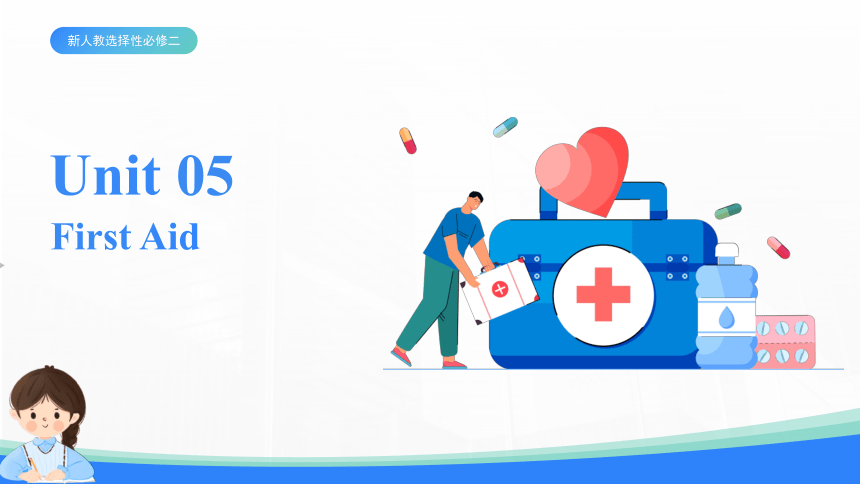 | |
| 格式 | pptx | ||
| 文件大小 | 16.5MB | ||
| 资源类型 | 教案 | ||
| 版本资源 | 人教版(2019) | ||
| 科目 | 英语 | ||
| 更新时间 | 2024-02-21 09:58:41 | ||
图片预览


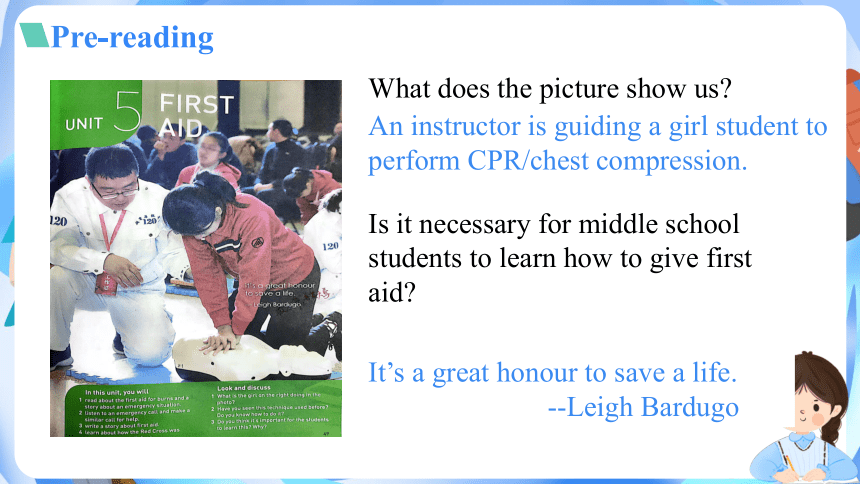
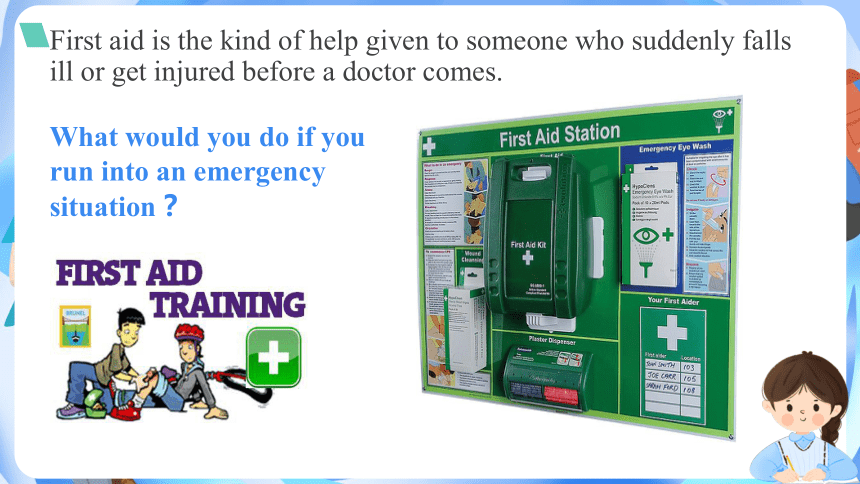
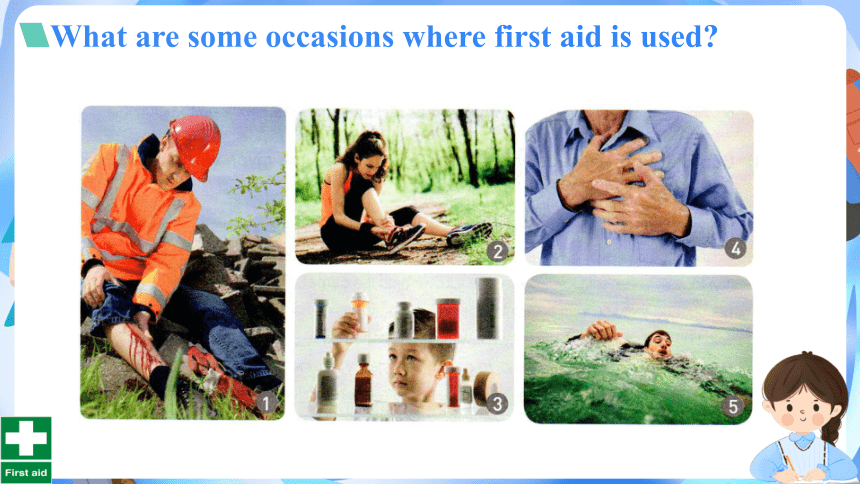

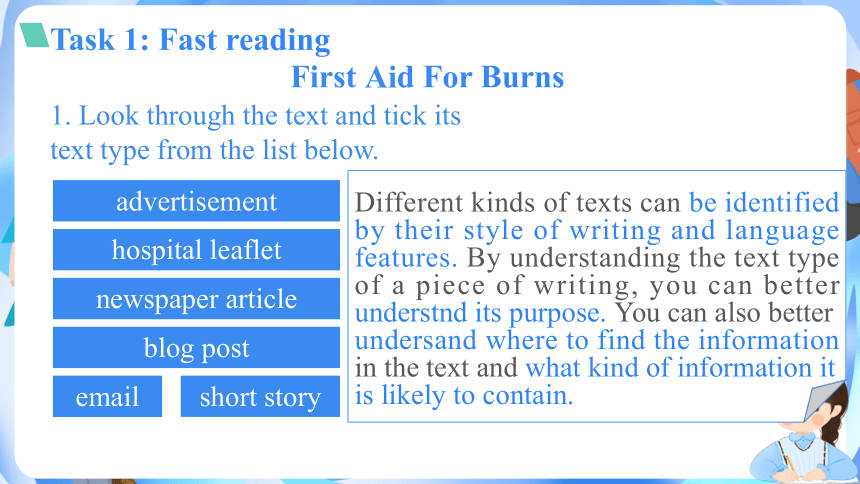
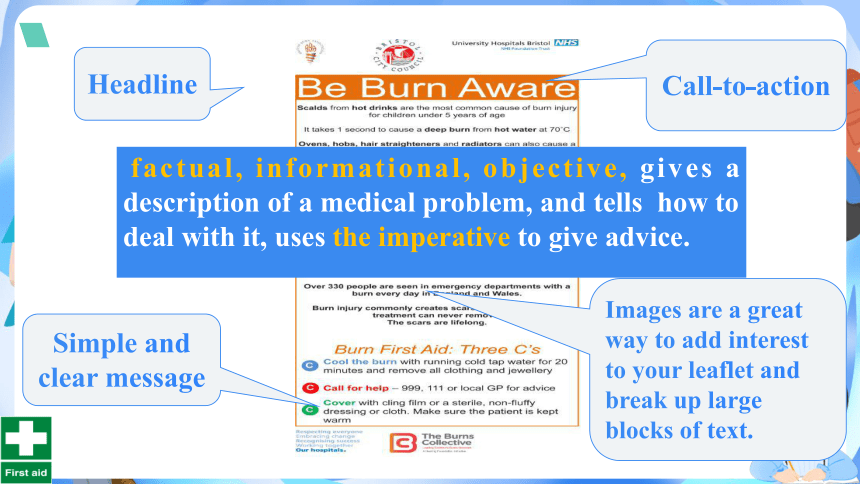
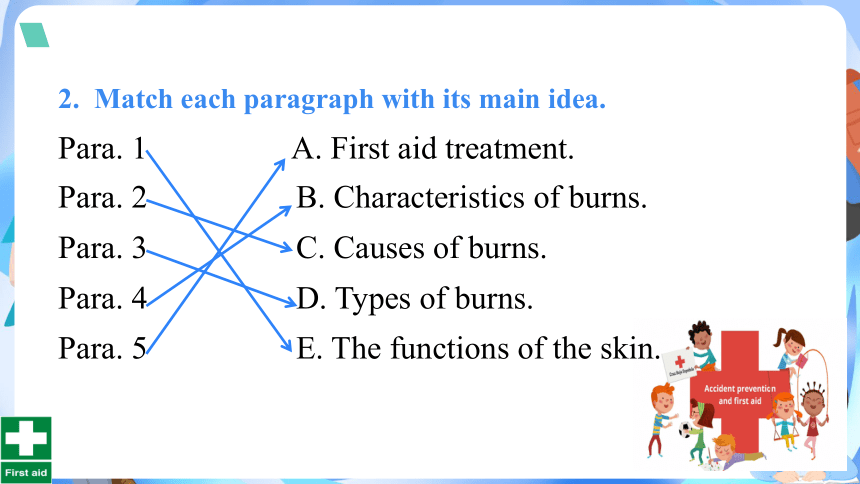
文档简介
(共29张PPT)
Unit 05
First Aid
新人教选择性必修二
Part 1
Pre-reading
What does the picture show us
An instructor is guiding a girl student to perform CPR/chest compression.
It’s a great honour to save a life.
--Leigh Bardugo
Is it necessary for middle school students to learn how to give first aid
Pre-reading
First aid is the kind of help given to someone who suddenly falls ill or get injured before a doctor comes.
What would you do if you run into an emergency situation?
What are some occasions where first aid is used
Part 2
While-reading
First Aid For Burns
Task 1: Fast reading
1. Look through the text and tick its text type from the list below.
advertisement
hospital leaflet
newspaper article
blog post
email
short story
Different kinds of texts can be identified by their style of writing and language features. By understanding the text type of a piece of writing, you can better understnd its purpose. You can also better undersand where to find the information in the text and what kind of information it is likely to contain.
Images are a great way to add interest to your leaflet and break up large blocks of text.
Simple and clear message
Headline
Call-to-action
factual, informational, objective, gives a description of a medical problem, and tells how to deal with it, uses the imperative to give advice.
2. Match each paragraph with its main idea.
Para. 1 A. First aid treatment.
Para. 2 B. Characteristics of burns.
Para. 3 C. Causes of burns.
Para. 4 D. Types of burns.
Para. 5 E. The functions of the skin.
Read the text carefully and answer the following questions.
1. How many functions of the skin have been mentioned
Five.
Task 2: Careful reading
An essential part of your body
steam
fire
the sun
chemicals
hot liquids
radiation
Causes of burns
acids
2.What are the Causes of burns
electricity
People divide the types of burns depending on the _________ of skin damage.
3.How do people divide the types of burns
depth
Details Types First-degree burns Second-degree burns Third-degree burns
Depth ______________ of the skin _____________ of the skin ______________ of the skin and sometimes ___________ underneath
top few
millimetres
below the top layer
every layer
the tissue
The top layer
The second layer
The third layer
4.Which of the following belongs to third-degree burns
A. Turn white when pressed.
B. Rough, red and swollen.
C. Extremely painful.
D. Black and white.
5.Retell the six steps of the first-aid treatment.
burns
Cool
Cover
burned area
Make sure
breathe
Send
victim
clothes
Remove
burnt area
Dry
Part 3
Post-reading
1. Your skin gives you protection from many dangerous things.
2. A first-degree burn has this name because it is the most serious.
3. Second-degree burns can be the most painful kind of burn.
4. It is important to use cool water to stop the heat from remaining in the wound regardless of the degree of the burn.
5. Putting butter or oil on burns helps because it may reduce swelling and ease discomfort.
T
F
T
T
F
1. Decide if the following statements are true (T) or false (F). (P51Q3)
The top few
millimeters
below the top
layer
every layer
the tissue
swollen
painful
white
blisters
watery
painful
the tissue
underneath
nerves
cool running
water
dry
remove
cover
breathe
the hospital at once
2. Complete the table to summarise the information about first aid for burns.
Part 4
Discussion
How are people most likely to get burnt
Most people are likely to get burnt at home: by knocking over a glass of hot water, by picking up a hot pan, or by getting cooking oil spilt on themselves.
What steps can be taken to help prevent these burns
Being aware of the danger is a good first step. For example, you should check to see if the burner is on before touching a pan on the stove. You should also use oven mitts when touching a hot pan. If you are using cooking oil, you should make sure that the pot is set firmly on the stove so that it cannot spill, and that it is not too full of oil.
REMEMBER: Prevention is better than cure.
Have the victim sit down and_______(提起)the foot.
Put an_________(冰袋)on the ankle to reduce the swelling.
________(喷洒) medicine around the ankle.
Put a firm bandage around the foot and ankle.
elevate
ice pack
Spray
Suffer from a spraind ankle
1._______(放置)the victim down and keep him still.
2. Put the bitten part_________than heart.
3. _________pressure to (施压) the bitten area with your hands and then with a bandage firmly over the bite.
4. Call medical help.
5. Don’t try to__________(吸出)the
venom (毒液).
Lay
higher
Apply
suck out
Get a snake bite
1.Get the person to sit down, put his head________ slightly.
2.Gently________ (捏) the soft part of the nose below the bridge (鼻梁).
forward
pinch
Get a nose bleed
Don’t move the broken bone if possible.
__________ (支撑) the broken arm in the most comfortable position.
Keep the arm_______(静止不动)using a sling(吊腕带) or support the broken arm with the other arm.
Get medical help immediately.
Support
still
Have a broken arm
1.Put a___________on the wound.
2.Apply__________to reduce the bleeding.
3.Send to__________if necessary.
bandage
pressure
hospital
Bleeding
If the person can cough (breathe, or speak), don’t do anything. If you_____(拍)her on the back, it can cause the piece of food to move and completely block the way.
2.If the person can’t cough and is turning blue in the face, make her____(吐)by her _______(拍)on the back.
3.Perform Heimlich manoeuvre if necessary. /'haimlik/ /m nu v (r)/
spit
patting
pat
Choking
How to Perform Heimlich manoeuvre
a. Stand behind the choking person
b. Wrap your arms around his waist(腰).
c. Put one fist in his or her upper part of the
stomach.
d. Grab your fist with your other hand tightly.
e. Force out the obstruction / b str k n/阻碍物
by pushing up and into his stomach in one motion.
Unit 05
First Aid
新人教选择性必修二
Part 1
Pre-reading
What does the picture show us
An instructor is guiding a girl student to perform CPR/chest compression.
It’s a great honour to save a life.
--Leigh Bardugo
Is it necessary for middle school students to learn how to give first aid
Pre-reading
First aid is the kind of help given to someone who suddenly falls ill or get injured before a doctor comes.
What would you do if you run into an emergency situation?
What are some occasions where first aid is used
Part 2
While-reading
First Aid For Burns
Task 1: Fast reading
1. Look through the text and tick its text type from the list below.
advertisement
hospital leaflet
newspaper article
blog post
short story
Different kinds of texts can be identified by their style of writing and language features. By understanding the text type of a piece of writing, you can better understnd its purpose. You can also better undersand where to find the information in the text and what kind of information it is likely to contain.
Images are a great way to add interest to your leaflet and break up large blocks of text.
Simple and clear message
Headline
Call-to-action
factual, informational, objective, gives a description of a medical problem, and tells how to deal with it, uses the imperative to give advice.
2. Match each paragraph with its main idea.
Para. 1 A. First aid treatment.
Para. 2 B. Characteristics of burns.
Para. 3 C. Causes of burns.
Para. 4 D. Types of burns.
Para. 5 E. The functions of the skin.
Read the text carefully and answer the following questions.
1. How many functions of the skin have been mentioned
Five.
Task 2: Careful reading
An essential part of your body
steam
fire
the sun
chemicals
hot liquids
radiation
Causes of burns
acids
2.What are the Causes of burns
electricity
People divide the types of burns depending on the _________ of skin damage.
3.How do people divide the types of burns
depth
Details Types First-degree burns Second-degree burns Third-degree burns
Depth ______________ of the skin _____________ of the skin ______________ of the skin and sometimes ___________ underneath
top few
millimetres
below the top layer
every layer
the tissue
The top layer
The second layer
The third layer
4.Which of the following belongs to third-degree burns
A. Turn white when pressed.
B. Rough, red and swollen.
C. Extremely painful.
D. Black and white.
5.Retell the six steps of the first-aid treatment.
burns
Cool
Cover
burned area
Make sure
breathe
Send
victim
clothes
Remove
burnt area
Dry
Part 3
Post-reading
1. Your skin gives you protection from many dangerous things.
2. A first-degree burn has this name because it is the most serious.
3. Second-degree burns can be the most painful kind of burn.
4. It is important to use cool water to stop the heat from remaining in the wound regardless of the degree of the burn.
5. Putting butter or oil on burns helps because it may reduce swelling and ease discomfort.
T
F
T
T
F
1. Decide if the following statements are true (T) or false (F). (P51Q3)
The top few
millimeters
below the top
layer
every layer
the tissue
swollen
painful
white
blisters
watery
painful
the tissue
underneath
nerves
cool running
water
dry
remove
cover
breathe
the hospital at once
2. Complete the table to summarise the information about first aid for burns.
Part 4
Discussion
How are people most likely to get burnt
Most people are likely to get burnt at home: by knocking over a glass of hot water, by picking up a hot pan, or by getting cooking oil spilt on themselves.
What steps can be taken to help prevent these burns
Being aware of the danger is a good first step. For example, you should check to see if the burner is on before touching a pan on the stove. You should also use oven mitts when touching a hot pan. If you are using cooking oil, you should make sure that the pot is set firmly on the stove so that it cannot spill, and that it is not too full of oil.
REMEMBER: Prevention is better than cure.
Have the victim sit down and_______(提起)the foot.
Put an_________(冰袋)on the ankle to reduce the swelling.
________(喷洒) medicine around the ankle.
Put a firm bandage around the foot and ankle.
elevate
ice pack
Spray
Suffer from a spraind ankle
1._______(放置)the victim down and keep him still.
2. Put the bitten part_________than heart.
3. _________pressure to (施压) the bitten area with your hands and then with a bandage firmly over the bite.
4. Call medical help.
5. Don’t try to__________(吸出)the
venom (毒液).
Lay
higher
Apply
suck out
Get a snake bite
1.Get the person to sit down, put his head________ slightly.
2.Gently________ (捏) the soft part of the nose below the bridge (鼻梁).
forward
pinch
Get a nose bleed
Don’t move the broken bone if possible.
__________ (支撑) the broken arm in the most comfortable position.
Keep the arm_______(静止不动)using a sling(吊腕带) or support the broken arm with the other arm.
Get medical help immediately.
Support
still
Have a broken arm
1.Put a___________on the wound.
2.Apply__________to reduce the bleeding.
3.Send to__________if necessary.
bandage
pressure
hospital
Bleeding
If the person can cough (breathe, or speak), don’t do anything. If you_____(拍)her on the back, it can cause the piece of food to move and completely block the way.
2.If the person can’t cough and is turning blue in the face, make her____(吐)by her _______(拍)on the back.
3.Perform Heimlich manoeuvre if necessary. /'haimlik/ /m nu v (r)/
spit
patting
pat
Choking
How to Perform Heimlich manoeuvre
a. Stand behind the choking person
b. Wrap your arms around his waist(腰).
c. Put one fist in his or her upper part of the
stomach.
d. Grab your fist with your other hand tightly.
e. Force out the obstruction / b str k n/阻碍物
by pushing up and into his stomach in one motion.
